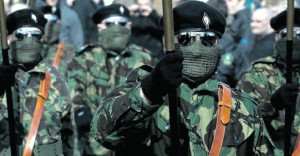La minaccia repubblicana è la più alta di sempre dopo l’esplosione della bomba di Omagh del 1998, fanno sapere fonti interne alla PSNI
Ex membri dei Provisional IRA, che si oppongono alla strategia di pace perseguita con lo Sinn Fein da Gerry Adams e Martin McGuinness, sarebbero coinvolti nella preparazione di alcuni ordigni.
La polizia pensa che i repubblicani stiano sviluppando competenze, stanno crescendo come numero e come fiducia.
Il livello di minaccia è stato innalzato a “grave” sin da febbraio 2009, appena un gradino sotto a “critico”, il livello più alto.
Poco dopo l’innalzamento, i genieri Patrick Azimkar e Mark Quinsey furono colpiti a morte all’esterno della caserma di Massereene Barracks ad Antrim.
Due giorni dopo il poliziotto Stephen Carroll fu assassinato quando la sua autovettura di pattuglia finì in un’imboscata a Craigavon.
Recentemente, attacchi bomba sono stati portati contro il tribunale di Newry e contro Palace Barracks a Holywood, dove trova sede il servizio segreto MI5.
Una fonte della polizia ha affermato: “Ci sono competenze che sarebbero state disponibili ai Provisional IRA, che sembrano utilizzate nella costruzione di alcuni di questi ordigni”.
La fonte ha aggiunto: “La situazione è peggiorata da quando il livello della minaccia è stata innalzata fino a ‘grave’. Questa probabilmente è una situazione grave quanto quella della campagna di esplosioni della Real IRA tra il 1997 ed il 1998… ci sembra, ad osservarla in ogni modo, che si sia incrementata in termini di intensità e gravità”.
L’autobomba lasciata all’esterno di Palace Barracks fu deliberatamente fatta esplodere in coincidenza con il trasferimento dei poteri su polizia e giustizia a Stormont.
La polizia adesso teme il tentativo dei repubblicani di contrastare il processo politico che sta portando alle elezioni generali.
Ci sono stati 10 attacchi finora nel 2010 e a febbraio la Real IRA ha giustiziato Kieran Doherty, 31 anni, a Derry.
Quasi 50 potenziali incidenti sono stati bloccati, secondo quanto riferito dalle fonti nella PSNI.
In seguito all’attacco contro l’agente cattolico Peadar Heffron, gravemente ferito nello scoppio di una bomba a gennaio e cui è stata amputata una gamba, i poliziotti hanno innalzato il loro livello di sicurezza personale.
“(I repubblicani) Sono molto consapevoli di mostrare il loro valore operativo e mostrare la loro credibilità. Non stanno agendo in condizioni di ristrettezza, come prima”, ha raccontato la fonte della PSNI.
“In precedenza non hanno avuto successo nel fare esplodere quelle bombe. Adesso ci riescono e dobbiamo pensare che hanno lavorato sulla progettazione e sulla costruzione.
“Senza dubbio ci sono ex membri (Provisional) IRA profondamente coinvolti in queste organizzazioni”.
Tratto da Utv
Dissident threat ‘highest since Omagh’
The dissident threat is higher than at any time since the Omagh bombing almost 12 years ago, PSNI sources have claimed.
Former members of the Provisional IRA, opposed to the Sinn Fein peace strategy of Gerry Adams and Martin McGuinness are suspected of involvement in preparing some of the devices, according to security sources.
Police believe dissidents are developing technical skills, as well as increasing numbers and growing confidence.
The threat level has been assessed as “severe” since February 2009, one below “critical”.
Shortly after the assessment, Sappers Patrick Azimkar and Mark Quinsey were shot dead outside Massereene army barracks in Antrim.
Constable Stephen Carroll was also killed when his patrol car was ambushed in Craigavon, Co Armagh.
Recently, bomb attacks occurred outside a courthouse in Newry and at Palace Barracks in Holywood, where the new Northern Ireland M15 headquarters is based.
A PSNI source said: “There is an element of skills which would have been available to the Provisional IRA, which are still obviously apparent in the construction of some of these devices.”
The source added: “The situation has got worse since the threat was raised to ‘severe’. This is probably as severe a situation as we’ve seen since that Real IRA bombing campaign of 1997 going into 1998…. It feels to us, just looking at it in every way, that this has picked up in terms of intensity and severity.”
The car bomb which went off outside Palace Barracks was deliberately timed to coincide with the transfer of policing and justice powers to Stormont.
Police are now wary the dissidents may attempt to disrupt the political process in the run-up to the General Election.
There have been 10 attacks so far this year as well as the murder by the Real IRA of Kieran Doherty, 31, in Derry in February.
Up to 50 other potential incidents, including targeting, have been disrupted according to sources.
Following the attack on PSNI officer and Irish language specialist Peadar Heffron, who was critically injured in a car bomb blast in January, officers have tightened personal security measures.
The source said: “They are very conscious about proving their operational worth and showing their credibility. They are not doing things on a wing and a prayer as before.
“Over time they have been unsuccessful in the detonation of these bombs. They are now successful and we have to assume they have actually worked on the design and build.
“Undoubtedly there are former (Provisional) IRA people deeply embedded in these organisations.”
